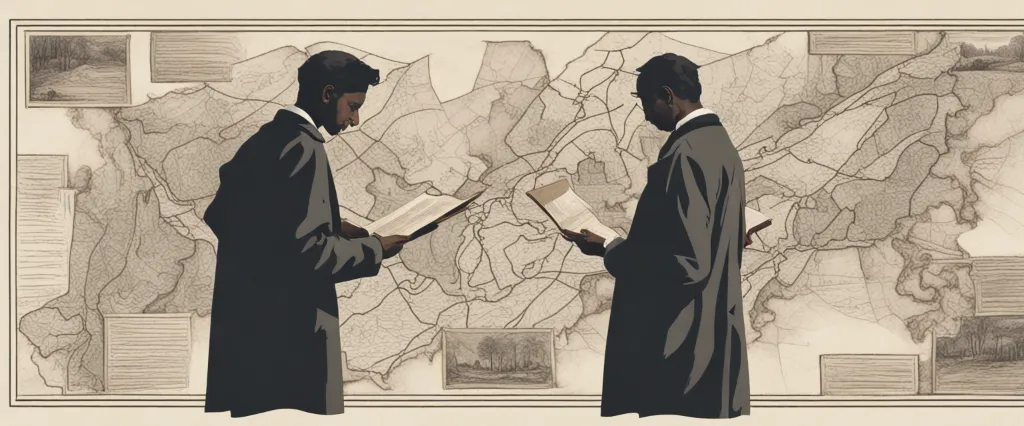
In the ever-changing landscape of our globalized world, the study of international relations has become an essential discipline to understand the complexities and dynamics that shape our societies. Among the vast array of thinkers and scholars in this field, two prominent figures stand out: Jared Diamond and Henry Kissinger. In their respective works, “Upheaval” and “World Order,” these intellectual giants delve into the intricate tapestry of historical events and geopolitical forces, offering unique perspectives on the challenges faced by nations and the pursuit of stability in a rapidly changing global order.
Jared Diamond, renowned for his rigorous approach to understanding the past, takes us on a journey exploring the collapse and resilience of nations. In “Upheaval,” he examines several case studies from different regions of the world, seeking to uncover the factors that have contributed to the rise and fall of civilizations. With an interdisciplinary approach blending anthropology, history, and sociology, Diamond uncovers a multitude of elements – both internal and external – that have played pivotal roles in shaping the trajectories of nations throughout history. Through his compelling analysis, Diamond raises profound questions about the impact of human actions on the courses of societies and poses thought-provoking insights into the choices nations must make to ensure their survival.
On the other hand, we have Henry Kissinger, a towering figure in international affairs whose vast experience as a diplomat and strategist grants him a unique perspective on global politics. In “World Order,” Kissinger delves into a comprehensive examination of the international system, analyzing the delicate balance of power, principles, and norms that govern interactions between nations. Drawing from his rich reservoir of knowledge and personal involvement in shaping world affairs, Kissinger presents a grand narrative that spans centuries, from the formation of modern nation-states to the complex dynamics of the contemporary world. With his trademark pragmatism and strategic thinking, Kissinger explores the intricate webs of relationships and interests that shape the global order, offering profound insights into the challenges faced by policymakers and the imperative for stability amidst recurring periods of upheaval.
As we embark upon a comparative study of these two exceptional works, we are presented with an opportunity to navigate the depths of their analyses, contrasting their approaches, emphasizing their convergences, and dissecting the nuances underlying their arguments. By examining the lenses through which Diamond and Kissinger view the world, we can gain a deeper understanding of the forces that have shaped our history, the factors that influence our present, and the pathways that may shape our shared future.
In the following pages, we will embark on a comparative journey, exploring the similarities and differences between “Upheaval” and “World Order,” unraveling the threads that connect their narratives, and examining the divergences that carve unique paths for each. Through this exploration, we aim to glean valuable insights into the complexities of international relations, challenging our perceptions, and broadening our intellectual horizons. By juxtaposing the lenses of these two exceptional scholars, we seek to shed light on the vast tapestry of world affairs, inviting us to contemplate the intricate dance between chaos and stability that shapes our globalized reality.
Brief Summary of Two Books
Upheaval by Jared Diamond
“Upheaval: Turning Points for Nations in Crisis” by Jared Diamond is a non-fiction book that examines the patterns and processes of societal collapse and resilience, drawing upon case studies from various nations and historical periods. Diamond focuses on twelve different countries that have faced significant crises, such as Finland, Japan, Chile, and Australia, and analyzes how they navigated through these challenges and ultimately transformed their respective societies.
Throughout the book, Diamond introduces a framework known as the “12 factors of political and social implosion,” which he uses to evaluate each nation’s stability and ability to overcome crisis. These factors include effective responses to challenges, national identity, a strong and competent government, and sound decision-making. Through extensive research, interviews, and personal experiences, Diamond explores these aspects in detail, drawing parallels between the countries to identify common paths to successful recovery and growth.
Through his analysis, Diamond argues that nations face both internal and external pressures, such as environmental factors, political discord, or economic instability, which can lead to societal collapse or revolution. He also emphasizes the significance of collective self-appraisal in times of crisis and highlights the importance of historical memory and the ability to learn from the past.
Ultimately, “Upheaval” provides a comprehensive look into how nations have endured and emerged from times of immense challenge, shedding light on the complex dynamics of resilience and transformation in societies. It encourages readers to contemplate the lessons that can be learned from history and to appreciate the significance of adaptation, self-reflection, and unity in times of crisis.
World Order by Henry Kissinger
World Order by Henry Kissinger provides an insightful analysis of the historical evolution and future prospects of world orders. Kissinger examines the global order from a geopolitical perspective and highlights the impact of various civilizations, especially those of Europe, China, and Islam, in shaping the modern world. The book delves into key historical events and their implications on the development of international relations.
Kissinger emphasizes the importance of balance of power and peace to maintain stability between nations. He argues that a truly global order cannot be achieved without the cooperation of major powers, including the United States, China, and other influential actors. The author further explores the complexities of multipolarity and the challenges faced by regions transitioning from a hegemonic order to a multipolar one.
In addition, Kissinger addresses the concept of sovereignty and its impact on international relations. He discusses the tension between national interests and the need for cooperation on global issues such as terrorism, nuclear proliferation, and environmental challenges. The book also delves into the concept of non-state actors and their growing influence on world affairs.
Throughout the book, Kissinger provides valuable insights based on his vast experience and knowledge in diplomacy and international affairs. He calls for an approach that balances power dynamics, respects diverse civilizations, and promotes cooperation to ensure a stable and just world order.
Overall, World Order offers a comprehensive analysis of global politics and provides readers with a deeper understanding of the complex dynamics that shape the world we live in. It serves as a thought-provoking guide for policymakers, scholars, and anyone interested in the future of international relations.
Comparison between Two Books

Similarities in Global Landscape
In both “Upheaval” by Jared Diamond and “World Order” by Henry Kissinger, the authors explore the global landscape and analyze the forces that shape it. While their approaches and perspectives differ, there are notable similarities in the way they discuss the challenges and potential solutions to global issues.
1. Historical perspective: Both authors emphasize the importance of understanding history to navigate the complexities of the global landscape. Diamond and Kissinger delve into historical examples to explain the origins of conflicts, power dynamics, and shifts in the international arena. By examining the past, they argue, we can better comprehend the current state of the world.
2. Crises and upheavals: The books share a focus on crises and upheavals that impact the global landscape. Diamond analyzes various societal crises throughout history, ranging from revolutions to economic collapses, and he identifies common patterns and elements that shape their outcomes. Meanwhile, Kissinger examines the historic challenges and disruptions faced by world powers, highlighting the importance of understanding past crises to effectively address contemporary issues.
3. Role of leadership: Both Diamond and Kissinger stress the critical role of leadership in shaping the global landscape. They discuss the abilities and qualities that leaders need to possess to effectively navigate crises, build cooperative relationships, and promote stability. Both authors argue that the decisions and actions of leaders have far-reaching consequences on world order.
4. Balance of power: Another similarity lies in the authors’ examination of the balance of power between nations. Diamond and Kissinger recognize the significance of power dynamics in shaping the global landscape. They explore how shifts in power, whether through military, economic, or technological means, can lead to instability or cooperation among nations.
5. Values and norms: Finally, both authors touch upon the importance of shared values and international norms in maintaining stability and order within the global landscape. Diamond and Kissinger discuss the role of culturally or ideologically driven challenges to these norms, as well as the potential for cooperation based on common interests and goals.
While “Upheaval” primarily focuses on the internal dynamics of societies, and “World Order” centers on international relations and diplomacy, the similarities discussed above demonstrate how Diamond and Kissinger both provide insights into the forces that shape the global landscape. Their historical analyses, examination of crises and leadership, consideration of power dynamics, and recognition of shared values offer readers valuable perspectives on understanding and addressing global challenges.
Divergences in Global Landscape
In comparing “Upheaval” by Jared Diamond and “World Order” by Henry Kissinger, it is evident that both books explore the global landscape and the factors that shape it, but they present different perspectives and diverge in their analysis of the current global order.
“Upheaval” focuses on understanding national crises and how countries have managed and recovered from them. Jared Diamond examines case studies from different countries, such as Finland, Chile, and Japan, to extract lessons that can be applied more broadly. Diamond emphasizes the importance of self-appraisal and national consensus as critical elements in successfully navigating upheavals. He argues that a nation’s future can be determined by its ability to honestly confront and learn from past crises.
On the other hand, “World Order” examines the current global order from a geopolitical standpoint, primarily through the lens of Henry Kissinger’s realist approach. Kissinger analyzes various historical and contemporary world powers, such as the United States, China, Russia, and the European Union, among others. Kissinger investigates the challenges and opportunities that arise from the interactions between these powers, particularly the complex dynamics of their shifting balance of power. He argues that an effective world order requires a pragmatic understanding of the interests, values, and ambitions of different nations.
While both books delve into the global landscape, there are divergences in their overall approach and focus. Diamond’s “Upheaval” focuses more on the internal dynamics of nations, their individual crises, and how they manage them. In contrast, Kissinger’s “World Order” adopts a broader perspective, examining the global landscape as a result of the interactions between different nation-states. Kissinger’s book is also more explicitly focused on the international relations of major powers and the implications for global stability.
Moreover, the books diverge in their underlying assumptions regarding the effectiveness of certain approaches. Diamond’s work emphasizes the importance of self-reflection and adaptation, suggesting that nations can learn from past crises to overcome future challenges. In contrast, Kissinger’s realist approach assumes that nations primarily act in self-interest and require a pragmatic understanding of the balance of power to maintain stability.
In summary, while both “Upheaval” by Jared Diamond and “World Order” by Henry Kissinger explore the global landscape, they diverge in their perspectives and approaches. Diamond’s book is more focused on internal crises within nations and the importance of self-reflection, while Kissinger’s work analyzes the interactions between major powers and emphasizes pragmatic understanding of their interests.

Conclusion
Both “Upheaval” by Jared Diamond and “World Order” by Henry Kissinger are highly regarded books that offer unique perspectives on global politics. The choice of which book is more worthy of reading depends on personal interests and the specific topics one wishes to explore.
“Upheaval” focuses on the theme of societal crises and how nations have historically responded to such challenges. It examines different countries, including Finland, Japan, Chile, and Germany, and delves into their experiences of overcoming crises, offering valuable lessons for the present and future. If you are interested in exploring the dynamics of societal change, resilience, and the implications of crisis management, “Upheaval” would be an excellent choice.
On the other hand, “World Order” by Henry Kissinger provides a comprehensive analysis of international politics and the principles that govern the global order. Kissinger draws on his extensive experience as a diplomat and offers insights into how nations interact on a global stage. If you are curious to understand the historical development of world order, the challenges it faces today, and the potential paths for a harmonious global system, “World Order” is an excellent book to read.
Ultimately, both books have their merits and offer valuable insights into different aspects of global affairs. If you are more interested in societal crises and responses, choose “Upheaval.” If you prefer a broader analysis of international relations and world order, “World Order” is the better choice.


